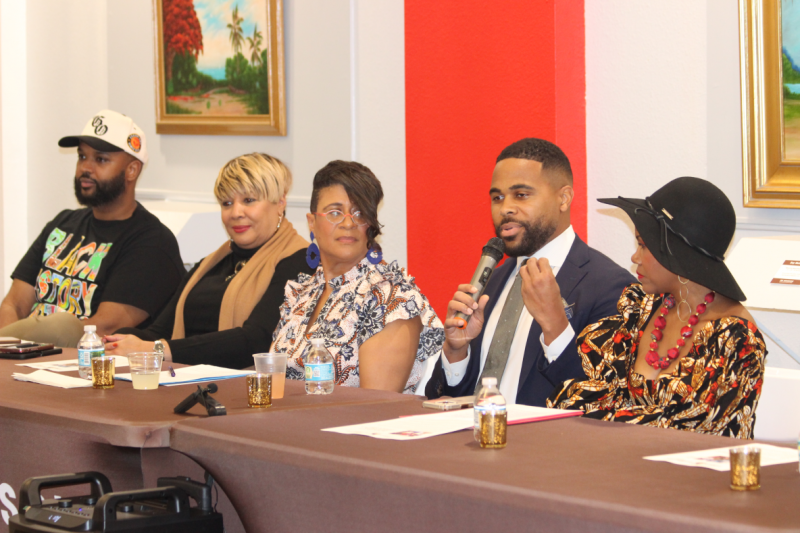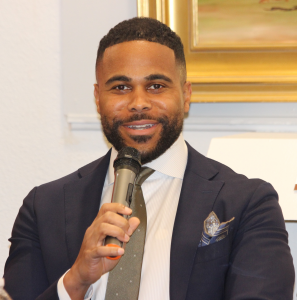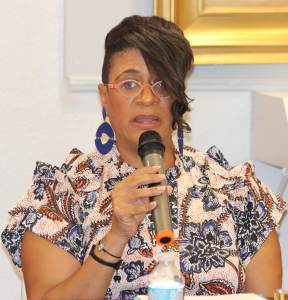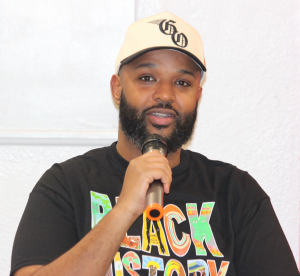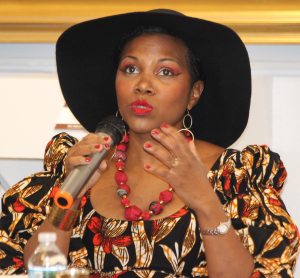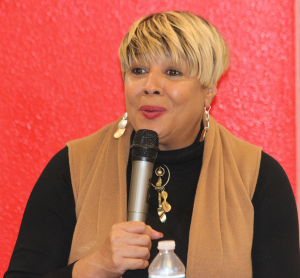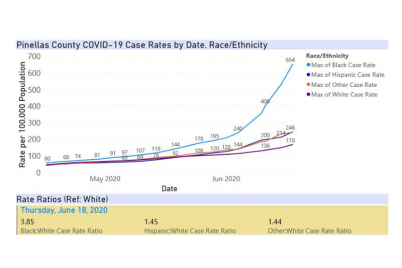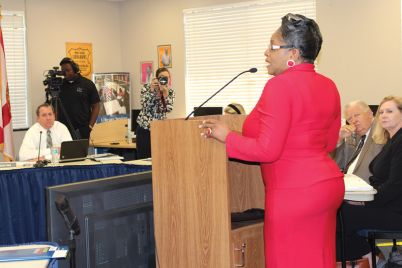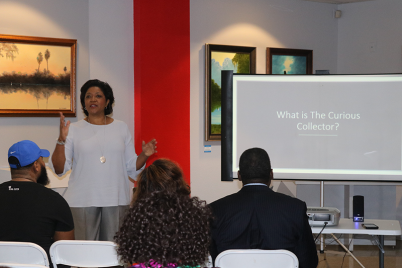When people think of philanthropy, most think of a Warren Buffett or a Bill Gates-type billionaire. However, African Americans give billions of dollars each year to philanthropic efforts.
BY FRANK DROUZAS | Staff Writer
ST. PETERSBURG — As part of the 2nd annual Tampa Bay Afrofuturism Festival, the Woodson African American Museum of Florida hosted a panel discussion on Black philanthropy moderated by interim Chief Equity Officer for the City of St. Petersburg Carl Lavender, Jr. on Nov. 10.
Christopher Hackney, SVP, director of SBA Lending at BayFirst National Bank, said he sees it as his mission to change the perception of the Black male when it comes to philanthropy.
“When you think about philanthropy, you know, the first thing that comes to your mind is probably not a Black male,” he stated. “It’s probably some affluent figure, older person, billionaire type; you don’t think about a young Black man.
Hackney said he wants to dispel some of the myths and make sure people know that it’s feasible, it’s reasonable and it’s our responsibility to change our perspective on philanthropy and change others’ perceptions of what a philanthropist is.
“When people think of philanthropy, they should think of this room, not Warren Buffett. It should be the people in this room and how collectively we can do just as much as that one man can do.”
Leigh Davis, former director of donor and advisor relations at Pinellas Community Foundation who has lived in 12 different states, said that philanthropy is a way for her to develop the Black community in each area where she has resided.
“Philanthropy is something that is very deeply personal,” she said, “and if you don’t have someone who’s not necessarily looking like you but understanding your background, what philanthropy is, it’s very different to white people, to Asian people, so to have people who are actually representative of you as your advisor in philanthropy. It’s critical to growing the idea of philanthropy.”
Too often, people associate philanthropy only with money; however, Terri Lipsey Scott, executive director of the Woodson African American Museum of Florida, pointed out that people can put value to their time and talent invested in helping others.
Liban Abokor, a representative of the Foundation For Black Communities in Toronto, found himself on the panel while here in St. Pete for the U.S. Department of State International Visitors Leadership Program (IVLP). The meeting was part of a 10-day program for IVLP leaders to learn how the U.S. stimulates and supports Black entrepreneurship through legislation, advocacy groups and NGOs, one-stop shops and educational programs.
Abokor said he doesn’t believe in altruism or appealing to morality, but he believes in appealing to justice.
“When I talk about philanthropy, I’ve never given; I’ve only returned,” he averred, adding that it is important to give back to those who have helped you along the way.
Lavender quoted a 2012 report by the W.K. Kellogg Foundation and Rockefeller Philanthropy Advisors that said approximately $11 billion was raised by African Americans in support of philanthropic efforts. The numbers are impressive when you look at the size of the Black population and assets.
There is a concern, Lavender said, that only about eight percent of total philanthropic dollars come to Black-and Brown-led philanthropic organizations as recipients.
Abokor said that in 2020, the Foundation for Black Communities wrote a report that revealed that for every $100 that foundations give, only seven cents went to Black communities in Canada.
“The question for us was, ‘Why?’ So, we mapped every single foundation, how much money they had, and we found that every one of their boards looked one way,” he said. “And a friend of mine once said, ‘If you’re not at the table, you’re on the menu.’ For us, it feels like we’re always being served, and by folks that should be in service of us.”
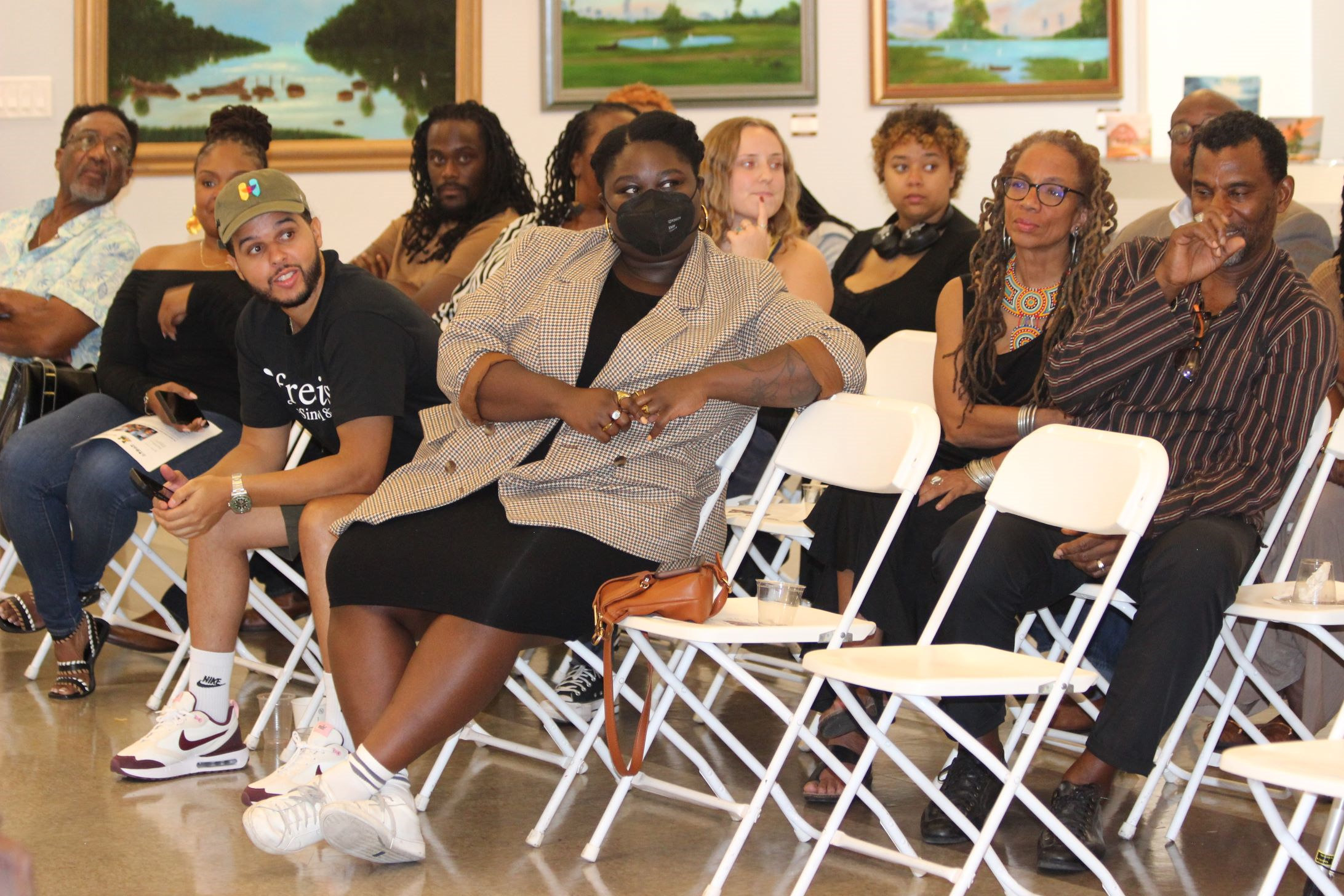
Moderator Carl Lavender, Jr. asked the audience if they knew how much was in their checking, savings, home equity, 401K or ROTH IRA accounts. ‘Do you know how much money you are worth? If you don’t know, it’s a great exercise,’ he said.
An American report, Abokor said, revealed much of the same disproportionate distribution by foundations here in this country. Part of the problem, he said, is that some of these well-meaning organizations do not have 501(c)(3) nonprofit status, which allows for federal dollars.
“We’re not looking to make money off our work, so we’re not thinking about established organizations that conform to the way that capital moves, but maybe we should be,” he said.
He added that people need “to give more love to Black fundraisers,” as they are “the heartbeat of philanthropy,” connecting those who have capital and those who need it.
“The challenge is, if we don’t use them, they don’t get paid, and then they often end up leaving and going elsewhere,” Abokor said.
Anysia McDowall, principal of Polestar Philanthropy, said donors and organizations that want to help address social issues must “take the time to understand and listen, and then for those organizations to have fundraisers or leaders that look like the people that they want to serve. That is critical to understanding a community.”
Davis noted that “giving circles” are a way to bring people together to discuss and decide where a pooled gift goes. She said they also help build awareness and volunteerism and provide dollars.
“It builds on the idea that you don’t have to be a millionaire to make a difference,” she said. “It’s very people-centered, and it’s very trust-based.”
Some tenets of trust-based philanthropy include not having to fill out extensive reports that keep the organization from getting out and providing its services. Also, the funder should know the organization and the people it serves, not just numbers on a page.
Another tenet of trust-based philanthropy is the idea of general operating support, she said.
“A lot of funding goes to specific programs and services when we’re not giving the nonprofits the foundation that they really need to succeed as businesses,” Davis said.
Davis said funders should give enough so that organizations can pay staff a living wage, build infrastructure, computers, technology, “all the things that they need to do their business and continue moving forward.”
Regarding corporate philanthropy, Hackney said Black employees can urge their companies to support Black organizations. Also, as many Black community members donate regularly to their churches, they should find a way to contribute to Black organizations as well.
McDowall said that we give where it is meaningful to us. Historically, we gave to the church, sororities, and fraternities in the African-American community because they were so critical to Black life as places that built up the community. Now, however, many other deserving institutions help progress the Black community.
She said when we come together around anything, there is power – that is a giving circle.
“Giving as that collective is so critical to making true change, and that could be in the form of $35, $25,” McDowall asserted. “When my family came to this country, they did not have much, and so that pooling together of aunties and friends in the neighborhood was what they did. That was their giving circle.”
As some cannot afford to give financially, they can volunteer their time and services, she said, be it taking care of elderly folks or baking goods to donate.
Lipsey Scott pointed out there is a difference between charity and philanthropic giving.
“When we think about charity, we’re giving for that immediate need,” she explained. “When we talk about philanthropic giving, we’re talking about long range, and with that, the commitments that we need to ensure whatever project you’re working on. It can’t be a one-and-done; you’ve got to make a commitment to whatever that thing is and stay with it.”
Lavender said Lipsey Scott’s campaign for the Woodson Museum is probably the most successful philanthropic drive on the books in St. Pete since she launched it some three years ago.
“The Woodson has been successful. We hear all over the city now: ‘Why are we doing a Black museum when we need a grocery store?’ My commitment has been to a museum. If your commitment is to the grocery store, I applaud those efforts … if we have a grocery store, should we not have a museum? Should we settle for a thing versus all the things our heart desires?”
Far too often, Black people fall through the cracks, Abokor said, and can’t depend on public institutions that don’t give fair access or equal access that we’re entitled to. During the lockdown phase of the pandemic, for example, Black organizations were the ones that were there to ensure we didn’t fall further.
“On every single metric that you look at, Black folks are either recovering slower than anyone else or either actually worse off,” he said. “We need a safety net when the safety net doesn’t work. And what philanthropy allows is the investment in that safety net.”
That same 2012 study reports that two-thirds of Black households engage in charitable giving, with much of that $11 billion going to the church.
Lipsey Scott is questioning the logic. Gone are the days when the Black church was the center of everyone’s lives and the heartbeat of the community. Of course, many churches serve their communities, but she asks people to examine the spending.
“We make investments in church every Sunday, and I’m going to be quite honest with you: where’s the return,” asked Lipsey Scott… Because we made this investment, and we’ve been making this investment for years – generations — and we still have the building fund. We’re still not feeding the hungry. We’re still not providing housing for the homeless, but we make that investment religiously.”
The panel discussion ended with a challenge. Abokor tasked those in attendance to gather and publish a list of the more than 9,000 foundations in the United States with grant sizes or endowments of over $500 million.
“The reason why it’s important is you can’t ask who you don’t know,” he said, adding that if anyone has access to a funder, encourage them to organize a “meet the funders” event.
“Funders can’t fund everyone, but if you make it their responsibility to know you or to know your community, it’s more likely that they [will] fund.”
Don’t miss the last weekend of events at the 2nd annual Tampa Bay Afrofuturism Festival:
- Friday, Nov. 17: 6-10 p.m. — Afrofuturists Paint n’ Party, Artz 4 Life, 1751 Kings Hwy., Clearwater
- Saturday, Nov. 18: 3 – 4:30 p.m. — Staged Play Reading, “AQ&REE: BROTHER FIRE, SISTER FLY” (ages 16+), Creative Pinellas, 12211 Walsingham Rd, Largo
- Saturday, Nov. 18: 8-11 p.m. — “Jazz/Hip Hop Showcase,” Catalyst on the Deuces, 903 22nd St. S, St. Pete
- Sunday, Nov. 19: 12-8 p.m. — “Black Futurists: The Sun RA/Zora Film Festival,” The Factory, St. Pete, 2622 Fairfield Ave. S, St. Pete
Click here for more information.

